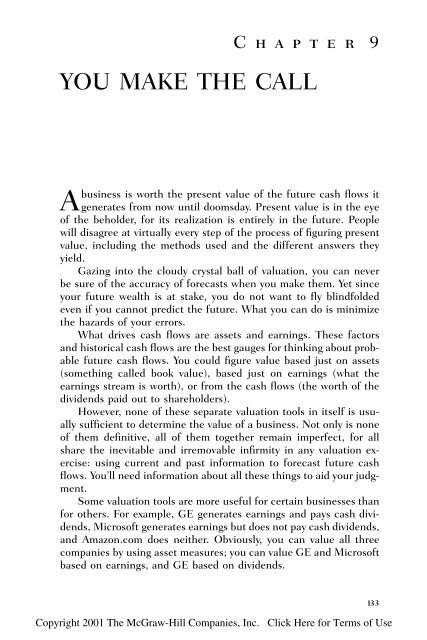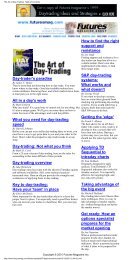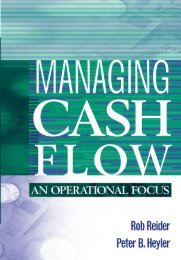- Page 2 and 3:
HOW TO THINK LIKE BENJAMIN GRAHAM A
- Page 4 and 5:
HOW TO THINK LIKE BENJAMIN GRAHAM A
- Page 6 and 7:
CONTENTS Acknowledgements ix Introd
- Page 8 and 9:
Contents vii Chapter 12. Rules and
- Page 10 and 11:
ACKNOWLEDGMENTS The main ideas in t
- Page 12 and 13:
INTRODUCTION: THE Q CULTURE Common
- Page 14 and 15:
Introduction: The QCulture xiii ing
- Page 16 and 17:
Introduction: The QCulture xv The n
- Page 18 and 19:
Introduction: The QCulture xvii •
- Page 20 and 21:
p a r t I A TALE OF TWO MARKETS Cop
- Page 22 and 23:
MR. MARKET’S BIPOLAR DISORDER C h
- Page 24 and 25:
Mr. Market’s Bipolar Disorder 5 p
- Page 26 and 27:
Mr. Market’s Bipolar Disorder 7 T
- Page 28 and 29:
Mr. Market’s Bipolar Disorder 9 p
- Page 30 and 31:
Mr. Market’s Bipolar Disorder 11
- Page 32 and 33:
Mr. Market’s Bipolar Disorder 13
- Page 34 and 35:
Mr. Market’s Bipolar Disorder 15
- Page 36 and 37:
PROZAC MARKET C h a p t e r 2 Along
- Page 38 and 39:
Prozac Market 19 puters. Using thos
- Page 40 and 41:
Prozac Market 21 casionally express
- Page 42 and 43:
Prozac Market 23 model was implying
- Page 44 and 45:
Prozac Market 25 market returns, wi
- Page 46 and 47:
Prozac Market 27 and cannot be sure
- Page 48 and 49:
Prozac Market 29 ments is not neces
- Page 50 and 51:
Prozac Market 31 horizons. The pate
- Page 52 and 53:
CHAOTIC MARKET C h a p t e r 3 Toda
- Page 54 and 55:
Chaotic Market 35 understanding of
- Page 56 and 57:
Chaotic Market 37 publication of a
- Page 58 and 59:
Chaotic Market 39 FIGURE 3-1 Driven
- Page 60 and 61:
FIGURE 3-3 Undriven pendulum time s
- Page 62 and 63:
Chaotic Market 43 Take a look at Fi
- Page 64 and 65:
Chaotic Market 45 geometry was deve
- Page 66 and 67:
Chaotic Market 47 The speed of intr
- Page 68 and 69:
Chaotic Market 49 (bouncing around)
- Page 70 and 71:
C h a p t e r 4 AMPLIFIED VOLATILIT
- Page 72 and 73:
Amplified Volatility 53 information
- Page 74 and 75:
Amplified Volatility 55 The most in
- Page 76 and 77:
Amplified Volatility 57 They then s
- Page 78 and 79:
Amplified Volatility 59 but that ne
- Page 80 and 81:
Amplified Volatility 61 one seeking
- Page 82 and 83:
Amplified Volatility 63 than of a p
- Page 84 and 85:
Amplified Volatility 65 nities for
- Page 86 and 87:
Amplified Volatility 67 ing of stoc
- Page 88 and 89:
TAKE THE FIFTH C h a p t e r 5 Know
- Page 90 and 91:
Take the Fifth 71 average market pr
- Page 92 and 93:
Take the Fifth 73 Strategies You mi
- Page 94 and 95:
Take the Fifth 75 ing three months
- Page 96 and 97:
Take the Fifth 77 way to preserve w
- Page 98 and 99:
Take the Fifth 79 markets those peo
- Page 100 and 101:
Take the Fifth 81 regarded “stock
- Page 102 and 103: Take the Fifth 83 economist of a pr
- Page 104 and 105: Take the Fifth 85 the 2000s produce
- Page 106 and 107: Take the Fifth 87 the path of days
- Page 108 and 109: P a r t II SHOW ME THE MONEY Copyri
- Page 110 and 111: APPLE TREES AND EXPERIENCE C h a p
- Page 112 and 113: Apple Trees and Experience 93 first
- Page 114 and 115: Apple Trees and Experience 95 the a
- Page 116 and 117: Apple Trees and Experience 97 “Do
- Page 118 and 119: Apple Trees and Experience 99 Lesso
- Page 120 and 121: Apple Trees and Experience 101 That
- Page 122 and 123: Apple Trees and Experience 103 winn
- Page 124 and 125: YOUR CIRCLE OF COMPETENCE C h a p t
- Page 126 and 127: Your Circle of Competence 107 Coca-
- Page 128 and 129: Your Circle of Competence 109 uatio
- Page 130 and 131: Your Circle of Competence 111 as wa
- Page 132 and 133: Your Circle of Competence 113 masse
- Page 134 and 135: Your Circle of Competence 115 CEO J
- Page 136 and 137: Your Circle of Competence 117 quire
- Page 138 and 139: RECOGNIZING SUCCESS C h a p t e r 8
- Page 140 and 141: Recognizing Success 121 short term
- Page 142 and 143: Recognizing Success 123 that neithe
- Page 144 and 145: Recognizing Success 125 its relativ
- Page 146 and 147: Recognizing Success 127 divides net
- Page 148 and 149: Recognizing Success 129 on a long-t
- Page 150 and 151: Recognizing Success 131 losses from
- Page 154 and 155: You Make the Call 135 This use of t
- Page 156 and 157: You Make the Call 137 bundle of int
- Page 158 and 159: You Make the Call 139 In assessing
- Page 160 and 161: You Make the Call 141 range of 8 to
- Page 162 and 163: You Make the Call 143 Believers in
- Page 164 and 165: You Make the Call 145 tical to the
- Page 166 and 167: You Make the Call 147 Neither of th
- Page 168 and 169: You Make the Call 149 look, industr
- Page 170 and 171: You Make the Call 151 of increasing
- Page 172 and 173: C h a p t e r 10 MAKING (UP) NUMBER
- Page 174 and 175: Making (Up) Numbers 155 (R&D) costs
- Page 176 and 177: Making (Up) Numbers 157 America for
- Page 178 and 179: Making (Up) Numbers 159 anddisclose
- Page 180 and 181: Making (Up) Numbers 161 to matter v
- Page 182 and 183: Making (Up) Numbers 163 buyers who
- Page 184 and 185: Making (Up) Numbers 165 As with Mer
- Page 186 and 187: Making (Up) Numbers 167 generatedre
- Page 188 and 189: P a r t I I I IN MANAGERS WE TRUST
- Page 190 and 191: GOING GLOBAL C h a p t e r 11 Warre
- Page 192 and 193: Going Global 173 bor markets, and v
- Page 194 and 195: Going Global 175 levels between sen
- Page 196 and 197: Going Global 177 shareholder-based
- Page 198 and 199: Going Global 179 reality even in ex
- Page 200 and 201: Going Global 181 owner orientation
- Page 202 and 203:
Going Global 183 Kingdom’s prime
- Page 204 and 205:
Going Global 185 takeover battles.
- Page 206 and 207:
Going Global 187 the pace of which
- Page 208 and 209:
Going Global 189 For investors, U.S
- Page 210 and 211:
Going Global 191 gence will dilute
- Page 212 and 213:
RULES AND TRUST C h a p t e r 12 An
- Page 214 and 215:
Rules and Trust 195 Managers raise
- Page 216 and 217:
Rules and Trust 197 orientation, ho
- Page 218 and 219:
Rules and Trust 199 outside the CEO
- Page 220 and 221:
Rules and Trust 201 worthiness, not
- Page 222 and 223:
Rules and Trust 203 the 1930s, this
- Page 224 and 225:
DIRECTORS AT WORK C h a p t e r 13
- Page 226 and 227:
Directors at Work 207 the successor
- Page 228 and 229:
Directors at Work 209 mendous, a bi
- Page 230 and 231:
Directors at Work 211 about 5% of a
- Page 232 and 233:
Directors at Work 213 Cascades of s
- Page 234 and 235:
Directors at Work 215 will resist t
- Page 236 and 237:
Directors at Work 217 the smartest
- Page 238 and 239:
Directors at Work 219 gage in huge
- Page 240 and 241:
THE FIRESIDE CEO C h a p t e r 14 T
- Page 242 and 243:
The Fireside CEO 223 1979, Welch ha
- Page 244 and 245:
The Fireside CEO 225 structures in
- Page 246 and 247:
The Fireside CEO 227 sharing them n
- Page 248 and 249:
The Fireside CEO 229 made for GE, h
- Page 250 and 251:
The Fireside CEO 231 chored on four
- Page 252 and 253:
The Fireside CEO 233 mation was the
- Page 254 and 255:
The Fireside CEO 235 teachers in so
- Page 256 and 257:
The Fireside CEO 237 brand strength
- Page 258 and 259:
The Fireside CEO 239 was in souther
- Page 260 and 261:
The Fireside CEO 241 stead is “an
- Page 262 and 263:
CONCLUSION: THE V CULTURE Readers w
- Page 264 and 265:
NOTES Chapter 1 1. Benjamin Graham,
- Page 266 and 267:
Notes 247 2. H. E. Hurst, “Long-T
- Page 268 and 269:
Notes 249 Smith, “Instinet, Datek
- Page 270 and 271:
Notes 251 9. Graham, Intelligent In
- Page 272 and 273:
Notes 253 Lessons for Corporate Ame
- Page 274 and 275:
Notes 255 (this is one of Berkshire
- Page 276 and 277:
COMPANY INDEX AdirondackTrading Par
- Page 278 and 279:
Company Index 259 Oracle, 211 Osaka
- Page 280 and 281:
Name Index 261 Kendall, Maurice, 18
- Page 282 and 283:
Subject Index 263 Circle of compete
- Page 284 and 285:
Subject Index 265 Macroeconomic fac
- Page 286 and 287:
Subject Index 267 Transaction volat
- Page 288 and 289:
‘‘This timely bookchallenges in




